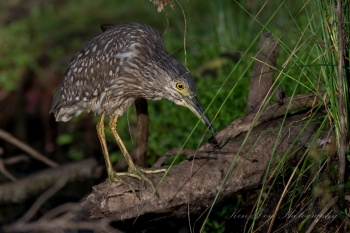(Alternative name. Picture of juvenile. References updated) |
m (→External Links) |
||
| (8 intermediate revisions by 4 users not shown) | |||
| Line 1: | Line 1: | ||
| − | [[Image:Rufous_Night_Heron.jpg|thumb| | + | [[Image:Rufous_Night_Heron.jpg|thumb|500px|right|Photo © by {{user|Neil|Neil Fifer}} <br/>Shot near Sydney, [[Australia]], September 2003]] |
| − | '''Alternative name: | + | '''Alternative name: Rufous Night Heron''' |
;[[:Category:Nycticorax|Nycticorax]] caledonicus | ;[[:Category:Nycticorax|Nycticorax]] caledonicus | ||
| − | |||
| − | |||
==Identification== | ==Identification== | ||
| − | + | 55–65 cm (21¾-25½ in) | |
| + | *Short heavy black bill | ||
| + | *Short think neck | ||
| + | *Greyish-black crown and nape | ||
| + | *Long white (or rufous) [[Topography#Heads|supercilium]] | ||
| + | *Whitish face | ||
| + | *Greenish-yellow [[Topography#Heads|lores]] and skin at lower [[Dictionary_M-O#M|mandible]] base | ||
| + | *Upper parts variable from pale cinnamon to maroon | ||
| + | *White underparts have a rufous wash | ||
| + | ====Variations==== | ||
| + | [[Image:Nankeen Night Heron1.jpg|thumb|350px|right|Juvenile<br />Photo © by {{user|Ken+Doy|Ken Doy}}<br />Cleveland, [[Queensland]], January 2018]] | ||
| + | Breeding: two or three long white crown plumes. Blue lores during courtship. Irises are red to orange. Legs turn bright pink or red. | ||
==Distribution== | ==Distribution== | ||
[[Philippines]] and Sulu Archipelago, north and west [[Borneo]] and [[Sulawesi]], [[Moluccas]], [[New Guinea]], [[Bismarck Archipelago]], [[Palau]] and [[Solomon Islands]] and [[New Caledonia]]. Also breeds over much of [[Australia]] except the arid interior. | [[Philippines]] and Sulu Archipelago, north and west [[Borneo]] and [[Sulawesi]], [[Moluccas]], [[New Guinea]], [[Bismarck Archipelago]], [[Palau]] and [[Solomon Islands]] and [[New Caledonia]]. Also breeds over much of [[Australia]] except the arid interior. | ||
| Line 11: | Line 20: | ||
==Taxonomy== | ==Taxonomy== | ||
====Subspecies==== | ====Subspecies==== | ||
| − | [[Image:Nankeen Night | + | [[Image:Nankeen Night Heron-.jpg|thumb|350px|right|Photo © by {{user|Ken+Doy|Ken Doy}}<br />Sandy Camp Rd Wetlands, [[Queensland]], [[Australia]], November 2018]] |
Six subspecies recognized<sup>[[#References|[1]]]</sup>: | Six subspecies recognized<sup>[[#References|[1]]]</sup>: | ||
* ''N. c. crassirostris'' formerly Bonin Islands; extinct since the late 1800s | * ''N. c. crassirostris'' formerly Bonin Islands; extinct since the late 1800s | ||
| Line 20: | Line 29: | ||
* ''N. c. caledonicus'' in [[New Caledonia]] | * ''N. c. caledonicus'' in [[New Caledonia]] | ||
==Habitat== | ==Habitat== | ||
| − | + | Inland and coastal fresh and brackish water. Swamps, rivers, streams and mangroves. Permanent and temporary flooded grassland. | |
| − | |||
==Behaviour== | ==Behaviour== | ||
| − | + | ====Diet==== | |
| − | + | They have a very varied diet consisting of small fish, amphibians, crustaceans, shrimps, reptiles, insects and occasionally eggs. | |
| − | + | ====Breeding==== | |
| + | They construct a nest platform out of sticks, in a colony, near water. The clutch contains 2-5 light green eggs which are incubated for 22-day; followed by a 42-49 day fledging period. | ||
==References== | ==References== | ||
| − | #{{Ref- | + | #{{Ref-Clements6thAug21}}#Handbook of the Birds of the World Alive (retrieved November 2018) |
| + | #Heron Conservation | ||
{{ref}} | {{ref}} | ||
==External Links== | ==External Links== | ||
| − | {{GSearch|Nycticorax | + | {{GSearch|"Nycticorax caledonicus" {{!}} "Nankeen Night Heron" {{!}} "Rufous Night Heron"}} |
| − | + | {{GS-checked}}1 | |
| + | <br /> | ||
| + | <br /> | ||
| + | |||
[[Category:Birds]] [[Category:Nycticorax]] | [[Category:Birds]] [[Category:Nycticorax]] | ||
Latest revision as of 16:47, 9 March 2023
Alternative name: Rufous Night Heron
- Nycticorax caledonicus
Identification
55–65 cm (21¾-25½ in)
- Short heavy black bill
- Short think neck
- Greyish-black crown and nape
- Long white (or rufous) supercilium
- Whitish face
- Greenish-yellow lores and skin at lower mandible base
- Upper parts variable from pale cinnamon to maroon
- White underparts have a rufous wash
Variations
Breeding: two or three long white crown plumes. Blue lores during courtship. Irises are red to orange. Legs turn bright pink or red.
Distribution
Philippines and Sulu Archipelago, north and west Borneo and Sulawesi, Moluccas, New Guinea, Bismarck Archipelago, Palau and Solomon Islands and New Caledonia. Also breeds over much of Australia except the arid interior.
Taxonomy
Subspecies
Six subspecies recognized[1]:
- N. c. crassirostris formerly Bonin Islands; extinct since the late 1800s
- N. c. manillensis in Philippines, east Borneo and Sulawesi
- N. c. australasiae from Australia and New Guinea west to Java
- N. c. mandibularis from Bismarck Archipelago to Solomon Islands
- N. c. pelewensis on Palau and Caroline islands
- N. c. caledonicus in New Caledonia
Habitat
Inland and coastal fresh and brackish water. Swamps, rivers, streams and mangroves. Permanent and temporary flooded grassland.
Behaviour
Diet
They have a very varied diet consisting of small fish, amphibians, crustaceans, shrimps, reptiles, insects and occasionally eggs.
Breeding
They construct a nest platform out of sticks, in a colony, near water. The clutch contains 2-5 light green eggs which are incubated for 22-day; followed by a 42-49 day fledging period.
References
- Clements, J. F., T. S. Schulenberg, M. J. Iliff, S. M. Billerman, T. A. Fredericks, J. A. Gerbracht, D. Lepage, B. L. Sullivan, and C. L. Wood. 2021. The eBird/Clements checklist of Birds of the World: v2021. Downloaded from https://www.birds.cornell.edu/clementschecklist/download/
- Handbook of the Birds of the World Alive (retrieved November 2018)
- Heron Conservation
Recommended Citation
- BirdForum Opus contributors. (2024) Nankeen Night Heron. In: BirdForum, the forum for wild birds and birding. Retrieved 24 May 2024 from https://www.birdforum.net/opus/Nankeen_Night_Heron
External Links
GSearch checked for 2020 platform.1






